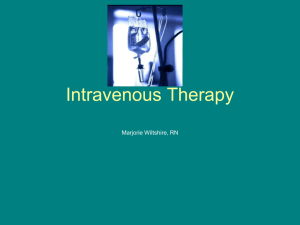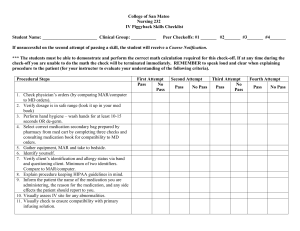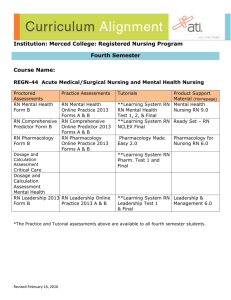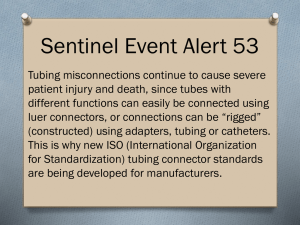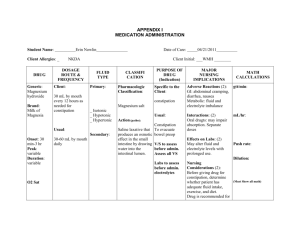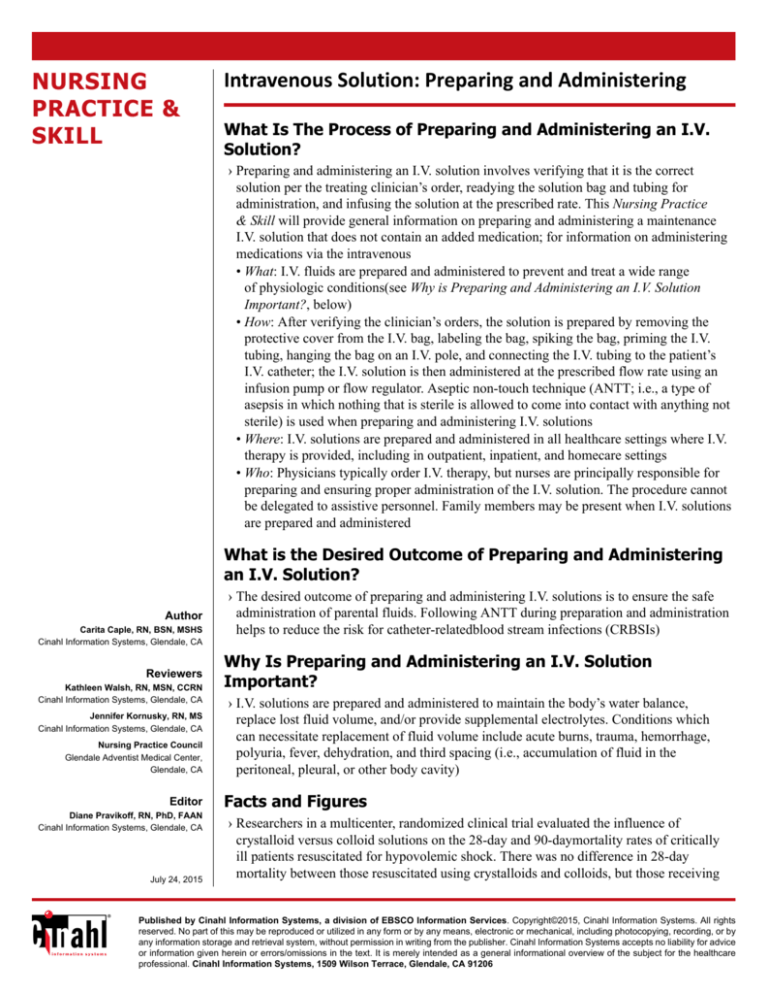
NURSING
PRACTICE &
SKILL
Intravenous Solution: Preparing and Administering
What Is The Process of Preparing and Administering an I.V.
Solution?
› Preparing and administering an I.V. solution involves verifying that it is the correct
solution per the treating clinician’s order, readying the solution bag and tubing for
administration, and infusing the solution at the prescribed rate. This Nursing Practice
& Skill will provide general information on preparing and administering a maintenance
I.V. solution that does not contain an added medication; for information on administering
medications via the intravenous
• What: I.V. fluids are prepared and administered to prevent and treat a wide range
of physiologic conditions(see Why is Preparing and Administering an I.V. Solution
Important?, below)
• How: After verifying the clinician’s orders, the solution is prepared by removing the
protective cover from the I.V. bag, labeling the bag, spiking the bag, priming the I.V.
tubing, hanging the bag on an I.V. pole, and connecting the I.V. tubing to the patient’s
I.V. catheter; the I.V. solution is then administered at the prescribed flow rate using an
infusion pump or flow regulator. Aseptic non-touch technique (ANTT; i.e., a type of
asepsis in which nothing that is sterile is allowed to come into contact with anything not
sterile) is used when preparing and administering I.V. solutions
• Where: I.V. solutions are prepared and administered in all healthcare settings where I.V.
therapy is provided, including in outpatient, inpatient, and homecare settings
• Who: Physicians typically order I.V. therapy, but nurses are principally responsible for
preparing and ensuring proper administration of the I.V. solution. The procedure cannot
be delegated to assistive personnel. Family members may be present when I.V. solutions
are prepared and administered
What is the Desired Outcome of Preparing and Administering
an I.V. Solution?
Author
Carita Caple, RN, BSN, MSHS
Cinahl Information Systems, Glendale, CA
Reviewers
Kathleen Walsh, RN, MSN, CCRN
Cinahl Information Systems, Glendale, CA
Jennifer Kornusky, RN, MS
Cinahl Information Systems, Glendale, CA
Nursing Practice Council
Glendale Adventist Medical Center,
Glendale, CA
Editor
Diane Pravikoff, RN, PhD, FAAN
Cinahl Information Systems, Glendale, CA
July 24, 2015
› The desired outcome of preparing and administering I.V. solutions is to ensure the safe
administration of parental fluids. Following ANTT during preparation and administration
helps to reduce the risk for catheter-relatedblood stream infections (CRBSIs)
Why Is Preparing and Administering an I.V. Solution
Important?
› I.V. solutions are prepared and administered to maintain the body’s water balance,
replace lost fluid volume, and/or provide supplemental electrolytes. Conditions which
can necessitate replacement of fluid volume include acute burns, trauma, hemorrhage,
polyuria, fever, dehydration, and third spacing (i.e., accumulation of fluid in the
peritoneal, pleural, or other body cavity)
Facts and Figures
› Researchers in a multicenter, randomized clinical trial evaluated the influence of
crystalloid versus colloid solutions on the 28-day and 90-daymortality rates of critically
ill patients resuscitated for hypovolemic shock. There was no difference in 28-day
mortality between those resuscitated using crystalloids and colloids, but those receiving
Published by Cinahl Information Systems, a division of EBSCO Information Services. Copyright©2015, Cinahl Information Systems. All rights
reserved. No part of this may be reproduced or utilized in any form or by any means, electronic or mechanical, including photocopying, recording, or by
any information storage and retrieval system, without permission in writing from the publisher. Cinahl Information Systems accepts no liability for advice
or information given herein or errors/omissions in the text. It is merely intended as a general informational overview of the subject for the healthcare
professional. Cinahl Information Systems, 1509 Wilson Terrace, Glendale, CA 91206
colloids demonstrated a lower 90-day mortality than did those receiving crystalloids. The
researchers called these findings exploratory, however, and stated that further study is
needed before a conclusion can be drawn regarding the efficacy of one over the other
(Annane et al., 2013)
What You Need to Know Before Preparing an I.V. Solution
› The clinician should be able to distinguish between various types of I.V. solutions and be aware of the potential adverse
effects of fluid replacement
• There are over 200 different types of I.V. fluids used in current clinical practice. These fluids can be classified
–according to tonicity (i.e., concentration of ions in the fluid; also called the osmotic pressure, osmolarity, or osmolality)
in comparison to blood plasma, which has an osmolality of about 290 milliosmoles per liter (mOsm/L). There are three
categories of I.V. solutions: isotonic, hypertonic, and hypotonic
- Isotonic fluids are fluids that are of equal or near-equal tonicity to blood plasma (240–340 mOsm/L). NS is an example
of an isotonic fluid
- Hypertonic fluids have a tonicity of > 340 mOsm/L. Hypertonic fluids include 3% or 5% NS and those that contain
albumin or dextrose
- Hypotonic fluids have a tonicity of < 240 mOsm/L. An example of a hypotonic fluid is 0.45% NS
–according to the state of particles within the solution (e.g., completely dissolved, incompletely dissolved). I.V. solutions
are typically referred to either being crystalloid (i.e., a solution in which particles are completely dissolved) or colloid
(i.e., a solution with dispersed, but not completely dissolved, particles)
- Crystalloids are solutions comprised of ions or sugars in water; these small molecular particles shift easily between the
body’s fluid spaces. Crystalloids include
- 0.9% sodium chloride (normal saline [NS])
- 0.25% saline
- 0.45% saline
- lactated Ringer’s (LR)
- 5% dextrose in water (D5W)
- dextrose 5% in saline (e.g., D5 0.45% saline or D5 0.9% NS)
- hypertonic saline (3% or 5%)
- Colloids are solutions containing larger molecular particles (e.g., albumin) that tend to remain within the intravascular
space, making this type of fluid useful for greater expansion of intravascular fluid volume. Colloids include
- albumin (i.e., plasma protein)
- dextran (i.e., polysaccharide)
- hetastarch (i.e., synthetic starch)
- mannitol (i.e., alcohol sugar)
• All I.V. solutions can potentially lead to fluid overload. Monitor for signs and symptoms of fluid overload (see Red Flags
, below) in all patients for whom I.V. fluid replacement has been ordered
› Prior to preparing and administering I.V. solutions, it is essential that the nurse have knowledge of the following nursing
responsibilities and tasks with regard to I.V. therapy:
• Monitoring the patency and condition of the I.V. line. Infection control protocols and standard precautions using NTAT
must be strictly followed when spiking I.V. bags and when connecting I.V. tubing to the patient’s I.V. catheter to avoid
exposure of the I.V. solution, tubing, or catheter to microorganisms that could cause local or systemic infection
–Changing the I.V. catheter, tubing, overlying dressing, and administration set according to facility guidelines will help
prevent CRBSIs. Most facilities follow evidence-basedpractice guidelines that require primary and secondary continuous
administration sets and I.V. catheters be changed every 96 hours to reduce the risk of infection, and that I.V. solutions be
changed every 24 hours
–Back-priming infusion methods are preferred when I.V. solutions are compatible to reduce the risk of contamination
caused by disconnecting secondary intermittent administration sets
–The potential for infection increases with the number of add-on devices (e.g., stopcocks, catheter hubs, extension sets,
needleless systems) and episodes requiring access
–The nurse clinician must assess the I.V. catheter and equipment per facility protocol using both inspection and palpation to
identify infiltration (Figure 1) , infection, phlebitis (Figure 2) , or other complication; if a complication occurs, the I.V.
catheter is removed and treatment administered per clinician’s order
–For more information on preventing I.V. therapy-relatedcomplications, see Nursing Practice & Skill … Intravenous
Therapy: Preventing Complications )
Figure 1: Example of infiltration at IV site. Copyright© 2014, EBSCO Information Services.
Figure 2: Example of phlebitis at IV site. Copyright© 2014, EBSCO Information Services.
–Medication administration. I.V. solutions are prescribed medications; adherence to the six “rights” of medication
administration (i.e., right patient, right drug, right dose, right time, right route, and right documentation [following
administration]) is essential to reduce the risk for medication errors and complications such as allergic reaction(for more
information on preventing medication errors, see Nursing Practice & Skill … Medication Errors: Preventing Errors
Associated with Intravenous Medications and Infusions )
–How to calculate the flow rate if the solution is to be administered using an I.V. pump and the drip rate if the solution is
to be administered via gravity (for more information, see Nursing Practice & Skill ... Intravenous Infusions, Continuous:
Calculating Doses and Flow Rates and Administering and Nursing Practice & Skill … Intravenous Infusions,
Continuous: Calculating the Drip Rate for a Gravity Flow Administration Set )
• Preliminary steps include the following:
–Review facility/unit-specific protocol for preparing and administering an I.V. solution, if available
–Review the treating clinician’s order for prescribed I.V. solution to be administered
–Verify completion of facility informed consent documents, as necessary
- Typically the standard consent to treat document completed on admission is sufficient to allow administration of I.V.
therapy
–Review the patient's medical history/medical record for
- indications for I.V. therapy
- any allergies (e.g., to latex, medications, or other substances); use alternative materials as appropriate
• Gather the necessary supplies, which typically include the following:
–Personal protective equipment (PPE; e.g., sterile/nonsterile gloves; use additional PPE [e.g., gown, mask, eye protection]
may be necessary if exposure to body fluids is anticipated)
–Medication administration record (MAR)
–Prescribed I.V. solution
–I.V. administration tubing
–I.V. infusion pump, if indicated
–I.V. pole
–Facility-approved I.V. solution label
–Needleless I.V. adapter
–Facility-approved antiseptic solution
–Written information to reinforce verbal education
How to Prepare and Administer an I.V. Solution
› Perform hand hygiene and don PPE, as needed
› Identify the patient using at least 2 unique identifiers, per facility protocol
› Establish privacy by closing the door to the patient’s room and/or drawing the curtain surrounding the patient’s bed
› Introduce yourself to the patient and family member(s), if present; explain your clinical role; assess the coping ability of the
patient and the family and for knowledge deficits and anxiety regarding preparing and administering an I.V. solution
• Determine if the patient/family requires special considerations regarding communication (e.g., due to illiteracy, language
barriers, deafness); make arrangements to meet these needs if they are present
–Use professional certified medical interpreters, either in person or via phone, when language barriers exist
• Explain the procedure, its purpose, and the patient’s expected participation during the procedure; answer all questions and
provide emotional support as needed
› Observe standard precautions and use ANTT throughout the procedure
› Assess the patient’s I.V site for redness, drainage, and pain (if the patient does not have an I.V. catheter in place, see Nursing
Practice & Skill … Peripheral Intravenous Cannula: Over-the-Needle Catheter Insertion )
• Remove and replace the I.V. in a new location if there are indications of infiltration, drainage, or infection
› Verify the first 5 “rights” of medication administration by checking the solution against the MAR and the clinician’s order
to ensure it is the right dose of the right solution, being prepared for the right patient, at the right time. Check the intended
infusion rate
› Remove the protective cover from the I.V. solution bag
›
› Visualize the I.V. solution
• Check the bag for punctures, cracks, or leaks, and the fluid inside the bag for clarity, color, and absence of particulate
matter
• Verify that the expiration date on the bag has not expired
› Label the I.V. solution bag with the date, time, patient’s name/room number, and your initials
› Unwrap the I.V. tubing and close the roller clamp
› Remove the protective covering over the I.V. tubing port of the I.V. solution
› Hold the spike port of the I.V. tubing in your dominant hand (do not allow the tubing to drop to the floor) and remove the cap
› Hold the I.V. solution in the nondominant hand, invert, and spike the I.V. solution by inserting the spike port into the I.V.
tubing port using ANTT. Ensure that the entire length of the spike is inserted securely into the port
• Do not allow your fingers to touch the spike
› Hang the I.V. solution bag on the I.V. pole, while keeping hold of the tubing in your opposite hand
› Rhythmically compress the drip chamber until the chamber is half full
› Remove the cap from the end of the I.V. tubing, open the roller clamp, and prime the tubing (i.e., allow the tubing to fill with
I.V. fluid)
› Once the tubing is completely primed, close the roller clamp and replace the cap
› Cleanse the patient’s needleless I.V. port by rubbing vigorously with an antiseptic agent (e.g., alcohol swab), according to
facility protocol; remove the cap from the end of the I.V. tubing and attach
• If not using a needleless port, disconnect the cap from the I.V. catheter, cleanse the catheter port;remove the cap from the
end of the I.V. tubing and attach to the catheter hub
› Open the roller clamp on the I.V. tubing and begin the infusion using one of the following two methods, per facility protocol:
• Adjust the clamp to regulate the flow of I.V. fluids via gravity at the prescribed drip rate
• Thread the tubing through the infusion pump, and program the pump to deliver the I.V. solution at the prescribed infusion
rate
› Discard used materials into the appropriate receptacle(s)
› Perform hand hygiene
› After administering the I.V. solution, document the following in the patient’s medical record
• Date and time solution was prepared and the infusion begun
• Name of the solution and rate of infusion
• Patient status prior to and after administration of the solution
• Any unexpected outcomes and the interventions performed
• All patient/family education
Other Tests, Treatments, or Procedures That May be Necessary Before or After
Preparing and Administering an I.V. Solution
› Frequently monitor the patient to observe for and document his or her response to the infusion, especially for adverse effects
related to the infusion and for I.V. complications (e.g., infiltration, phlebitis)
What to Expect After Preparing and Administering an I.V. Solution
› The I.V. solution is prepared correctly and using aseptic technique
› The I.V. solution is infused at the rate ordered by the treating clinician
Red Flags
› Monitor for fluid overload in all patients receiving I.V. fluids. Signs and symptoms include jugular venous distention,
increased weight, hypertension, increased intake versus output, adventitious breath sounds, shortness of breath, and a rise in
heart and respiratory rate; fluid overload can result in or exacerbate heart failure. The treating clinician should be notified
immediately, and the patient is generally treated with diuretics and oxygen therapy
› Risk for hypersensitivity and anaphylaxis is increased in patients who are receiving colloids, particularly albumin
› LR can increase serum potassium levels which increases risk for cardiac arrhythmias . Monitor electrolyte levels in
patients receiving LR
What Do I Need to Tell the Patient/Patient’s Family?
› Explain to the patient/family/caregiver the purpose of and steps involved in I.V. fluid therapy, and address any questions or
concerns they may have
› Reinforce to the patient the importance of notifying the clinician of discomfort or other symptoms experienced during the
infusion
References
1. Altman, G.B. (2010). Medication administration. In G. B. Altman (Ed.), Fundamental & advanced nursing skills (3rd ed., pp. 642-647). Clifton Park, NY: Delmar Cengage
Learning.
2. Annane, D., Siami, S., Jaber, S., Martin, C., Elatrous, S., Declère, A.D., ... Chevret, S. (2013). Effects of fluid resuscitation with colloids vs crystalloids on mortality in critically ill
patients presenting with hypovolemic shock: The CRISTAL randomized trial. JAMA, 310(17), 1809-1817. doi:10.1001/jama.2013.280502
3. Hamilton, S. (2014). Intravenous therapy. In S. M. Nettina (Ed.), Lippincott manual of nursing practice (10th ed., pp. 82-101). Philadelphia, PA: Wolters Kluwer Health/
Lippincott Williams & Wilkins.
4. Infusion Nurses Society. (2011). Infusion nursing standards of practice. Journal of Infusion Nursing, 34(1s), s31; s55.
5. Mulvey, M. (2014). Fluid and electrolytes: Balance and disturbance. In J. L. Hinkle & K. H. Cheever (Eds.), Brunner & Suddarth’s textbook of medical-surgical nursing (13th
ed., Vol. 1, pp. 272-283). Philadelphia, PA: Wolters Kluwer Health/Lippincott Williams & Wilkins.

